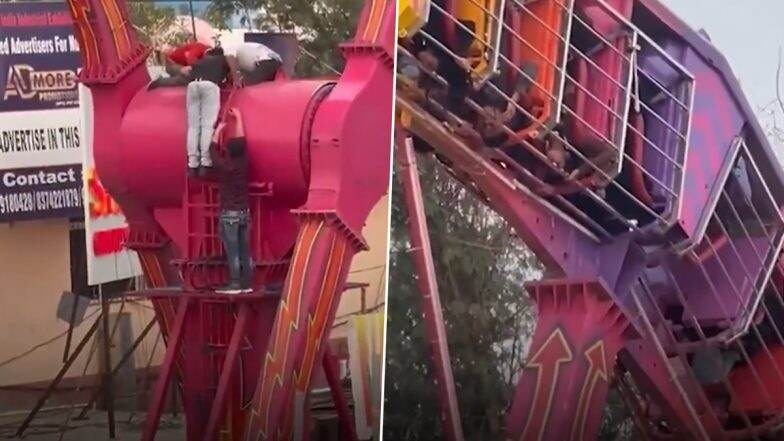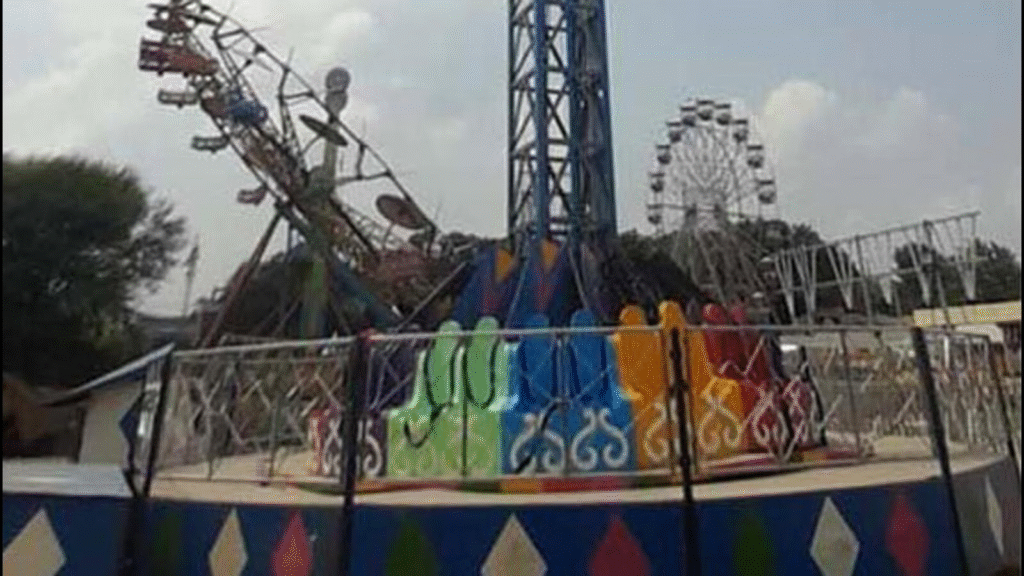
Chennai, a bustling city known for its rich culture and vibrant lifestyle, recently witnessed a chilling incident that shook visitors and locals alike. What was supposed to be a day filled with fun and laughter at a popular amusement park turned into an agonizing ordeal when a joyride malfunctioned, leaving 30 people suspended high above the ground for several hours. This harrowing experience exposed glaring safety issues and sparked a debate about amusement park regulations and visitor security.
The Incident That Shook Chennai’s Amusement Park Scene
On a bright and sunny afternoon, visitors flocked to one of Chennai’s well-known amusement parks to enjoy a variety of rides and attractions. Among the crowd, the high-flying joyride stood out as a favorite — promising panoramic views and a thrilling experience that would create lasting memories. Families, friends, and thrill-seekers eagerly waited their turn to ascend into the air.
However, what started as an exhilarating adventure quickly took a terrifying turn. Midway through the ride, the machinery malfunctioned unexpectedly, causing the entire ride to come to a sudden halt. Thirty people found themselves trapped mid-air, suspended tens of feet above the ground, unable to move or escape the sweltering heat.
The atmosphere instantly shifted from excitement to panic. Passengers clung to their seats, hearts pounding with fear as they realized their predicament. The silence was punctuated by cries for help and anxious conversations, as the trapped individuals grappled with their new reality — stuck in the air with no immediate rescue in sight.
Park staff swiftly responded by alerting emergency services and attempting to reassure those stranded. Yet, despite their best efforts, the technical complexity of the ride meant that quick fixes were not possible. Time dragged on as the riders remained immobilized, leading to growing distress among families watching from below.
Hours of Fear and Bravery: The Rescue Operation
As minutes turned into hours, the gravity of the situation deepened. Emergency responders, including firefighters and medical teams, rushed to the scene equipped with specialized gear. The rescue operation became a delicate balancing act, with every movement needing to be calculated to avoid further endangering the trapped passengers.
Firefighters brought in hydraulic platforms and harnesses, planning to evacuate each individual one at a time. Communication was crucial throughout, with rescuers maintaining constant contact to monitor passengers’ physical and mental states. Many of those stranded showed remarkable courage, supporting each other and staying calm despite the intense heat and fear.
The rescue unfolded with painstaking care, prioritizing safety over speed. Each passenger was carefully lowered to the ground, where medical personnel provided immediate care. Thankfully, no serious injuries were reported, though some suffered from dehydration and exhaustion due to the prolonged exposure to the sun and stress.
The successful evacuation after several grueling hours was met with an outpouring of relief and gratitude. Onlookers applauded the rescuers, praising their professionalism and dedication. Families reunited with their loved ones, many overwhelmed by the ordeal but thankful for a safe ending.
Examining the Causes: What Went Wrong?
In the aftermath of the incident, attention turned to uncovering the root cause of the malfunction. Initial investigations suggested a mechanical failure, though the exact nature of the breakdown remained under scrutiny. Park officials vowed full cooperation with authorities and promised transparency as the inquiry progressed.
This incident cast a harsh light on amusement park safety protocols. Questions were raised about the frequency of maintenance checks, the adequacy of staff training, and the readiness of emergency procedures. Safety experts emphasized the need for rigorous inspections and strict adherence to international standards to prevent similar tragedies.
The park’s management expressed deep regret over the incident, assuring the public that they would implement comprehensive safety reforms. They announced plans for independent audits, upgrades to machinery, and enhanced emergency preparedness measures to restore public confidence.
Emotional Toll on Passengers and Public Response
For those who endured hours suspended mid-air, the experience was traumatic. Many recounted feelings of helplessness and fear, intertwined with moments of solidarity and hope as they supported each other. Several passengers expressed their gratitude to the rescuers, acknowledging the calm and effective response despite the challenging circumstances.
News of the incident quickly spread across social media platforms, with videos and firsthand accounts drawing sympathy and concern from the wider public. The shared experience resonated deeply, igniting discussions on safety standards and the responsibility of amusement parks toward their visitors.
In the days following the incident, visitor numbers to the park dropped noticeably. Families expressed hesitation about returning, concerned about their own safety and the reliability of the park’s operations. The incident has had a tangible impact on the park’s reputation and revenue, underscoring the critical importance of maintaining trust through safety assurance.
Industry-Wide Implications: Safety Under the Spotlight
While the tragedy was localized to one park in Chennai, its ramifications ripple across the amusement industry nationwide. The incident serves as a stark reminder that with increasing popularity of thrill rides, operators must prioritize safety without compromise.
Experts and regulators alike are calling for sweeping reforms. Suggestions include mandatory certification of rides by accredited agencies, regular third-party safety inspections, and rigorous training programs for operators and emergency staff. Enhanced regulatory oversight is seen as essential to safeguard public welfare.
Consumer advocacy groups are demanding more transparent reporting systems for ride malfunctions and accidents, aiming to create accountability and prevent cover-ups. The goal is to foster a culture where visitor safety is paramount and where amusement parks are held to the highest standards.
Rebuilding Public Trust: Challenges and Opportunities
The road to regaining visitor trust is long and challenging. The affected amusement park has initiated a series of measures aimed at reassuring the public. These include upgrading ride infrastructure, conducting transparent safety demonstrations, and engaging with community stakeholders through informational campaigns.
Counseling services have also been made available for those psychologically affected by the ordeal, acknowledging that trauma is not only physical but emotional as well. The park management has committed to frequent updates and open communication as they implement reforms.

Public education about amusement ride safety is another key focus area. By informing visitors about what to expect and how to respond in emergencies, parks can empower their guests and reduce anxiety about potential risks.
Safety in Amusement Parks: The Fine Line Between Thrill and Risk
Amusement parks represent the epitome of fun and excitement, drawing millions of visitors each year. However, the inherent risks in operating complex rides demand an unwavering commitment to safety. The Chennai incident starkly illustrates the consequences when this balance is disrupted.
Thrill rides are mechanical marvels requiring precise engineering, regular upkeep, and skilled operation. The slightest oversight can lead to catastrophic failures. It is imperative that parks invest in state-of-the-art technology, preventive maintenance, and continuous staff training to mitigate risks.
Moreover, the expectations of visitors have evolved. Today’s guests seek not only exhilaration but assurance that their well-being is safeguarded. Transparent safety measures and emergency preparedness can significantly enhance visitor confidence.
Technological Advances and Their Role in Ride Safety
Emerging technologies offer promising solutions to enhance amusement ride safety. Smart sensors, real-time monitoring systems, and automated shutdown mechanisms can detect anomalies early and prevent accidents.
The integration of artificial intelligence and predictive maintenance can forecast potential failures before they occur, allowing for timely repairs. Additionally, virtual reality training for operators and emergency responders can improve preparedness for crisis scenarios.
Parks that embrace these innovations position themselves as leaders in safety and customer care, setting new industry benchmarks.
Community and Regulatory Response: Driving Change
In the wake of the Chennai incident, local authorities and community leaders have voiced strong support for reforms. Regulatory bodies are reviewing existing safety guidelines, contemplating stricter licensing requirements and tougher penalties for non-compliance.
Public forums and stakeholder meetings are being organized to solicit input from visitors, experts, and park operators. This collaborative approach aims to create comprehensive policies that prioritize safety without stifling innovation and entertainment value.
Community vigilance is also encouraged, empowering visitors to report safety concerns and demand accountability.
Lessons Learned and the Path Forward
The joyride malfunction in Chennai is a sobering lesson for the amusement park industry. It underscores the critical importance of constant vigilance, robust safety protocols, and a proactive approach to risk management.
Moving forward, a multi-pronged strategy involving technological upgrades, regulatory oversight, operator training, and community engagement is essential. Parks must view safety not as a compliance requirement but as the foundation of their business and reputation.
For visitors, awareness and preparedness remain key. Understanding safety instructions, following park guidelines, and staying calm during emergencies can make a significant difference.
As the park works to recover and rebuild, this incident may well serve as a catalyst for a safer and more secure amusement park experience across India.
Conclusion: Turning a Nightmare into a Catalyst for Safety
The incident that left 30 people hanging mid-air for hours in Chennai was a dramatic reminder of the unpredictability of mechanical systems and the high stakes involved in amusement park operations. While the event caused distress and fear, it also sparked an overdue conversation on safety reforms.
The swift rescue and lack of severe injuries provided a silver lining, showcasing the effectiveness of coordinated emergency response. Yet, the real victory will come from implementing lasting changes that prevent such incidents from recurring.
By embracing transparency, investing in technology, and fostering a culture of safety, amusement parks can restore public trust and ensure that joyrides remain moments of happiness rather than horror.
This incident stands as a turning point, urging all stakeholders to place visitor safety at the heart of every thrill.

